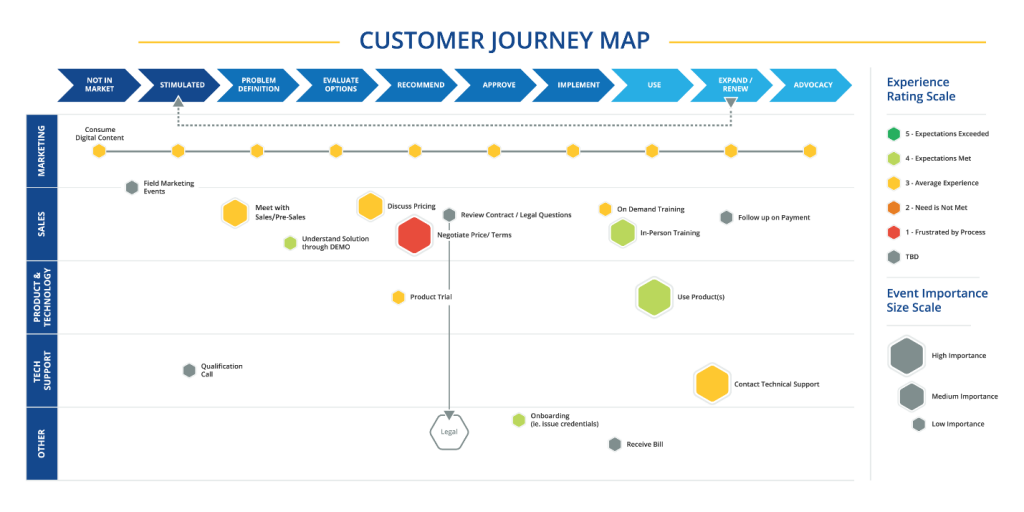An effective go-to-market model has three primary benefits for a company. First, it supports a more efficient motion that minimizes your cost of new customer acquisition. Second, it enables your commercial team to capture greater wallet share from existing customers and grow their lifetime value. And third, it helps manage the expense-to-revenue (E:R) ratio of the business and ensure spend per segment is optimized.
For CEOs and commercial leaders, getting your GTM model right is one of the most important commercial efforts you undertake. It’s critical to ensure that you are designing your model in a way that both supports the short-term plan as well as drives towards the long-term vision and strategy. In order to design the optimal GTM model, you need to account for the appropriate inputs — market potential, target accounts, product-market fit, etc. — as well as external factors, such as how the competition goes to market. For example, a company that is introducing a new product with significant market potential will have a different GTM model than one where new product introduction is scarce and remaining market potential is limited.
Given all of this, it can be overwhelming to figure out what that optimal GTM model truly is. You may have tinkered with your model over the past ~18 months as you navigated the pandemic (e.g., tested an inside sales motion), and it is likely you learned a few things relative to what works and what doesn’t. But with 2022 just around the corner and many companies kicking off their annual planning process, it is important to cement your GTM model going into next year. One way to start that effort is by baselining with your commercial leadership team what is and what is not working today, so you can begin addressing those areas that need improvement. Using our Growth Index as a commercial leadership team is a great way to get started on that; the output will highlight areas of alignment (and where it’s lacking) within the leadership team. In addition, you’ll receive helpful benchmarks to show what your revenue growth strategy and execution bets look like when compared with peers.
As you develop your baseline, it is important to keep in mind what is needed in order to improve. SBI has spent months researching and looking into how companies are preparing for next year; from this effort, there are three consistent themes that arise across a majority of the companies.
Theme #1 - Improving Commercial Spend Efficiency
The first theme that arose is a majority of the CEOs we spoke with are seeking ways to improve their commercial spend efficiency. In short, they are trying to find how to get more yield from their commercial functions.
CEOs recognize how the past ~18 months impacted the previously (slightly) more predictable commercial model. For example, before the pandemic, many leaders assumed that ~70% of their sales organization would hit quota. Once the pandemic struck, that assumption was thrown out the window and was impacted by many other factors than just your sales team’s talent (e.g., supply chains, demand, labor availability). This resulted in much more varied commercial spend yields and production levels for CEOs across many companies.
Going into the next year, CEOs are working on improving their commercial spend and generating more yield from their teams. To do this they are focusing on three things:
- Driving effective resource allocation across their different Routes-to-Market
- Clearly defining the role of the channel and how that will contribute to growth
- Re-calibrating productivity and yield expectations of the team with the revised GTM model
There is a great benefit for CEOs in improving their commercial spend efficiency and generating greater yield from the commercial team.
Theme #2 - Balancing Wallet Share Capture & New Logo Acquisition
As markets have started to re-open, companies are spending more on external goods, services, and products. As a result, commercial teams are starting to “get busy” again, both acquiring new customers and serving existing customers.
With the need for new customers being critical for any business, many of the CEOs we spoke with going into the next year are focused on balance — that is, capturing greater wallet share from existing customers while also focusing on bringing in new logos. They know that doing this diversifies their revenue streams while driving up Customer Lifetime Value.
The GTM model that a company deploys will be different when it’s focused on new logo acquisition versus capturing greater customer wallet share. For example, the main thing to account for when designing a model optimized for capturing greater wallet share is the role of each commercial function — Sales, Marketing, and Customer Success — and how they are working together to capture more share. A model focused more on new logo acquisition, however, will lean (much) less on Customer Success and (much) more on Marketing. CEOs need to drive the leaders of those functions to align on the critical activities needed to capture greater revenue in existing customers and ensure there is clarity in how it will all get done.
Theme #3 - Normalizing Expense-to-Revenue
Expense-to-Revenue (E:R) is a critical business metric that, as the name describes, is the ratio of expense and revenue for a business. Often looked at by segment (e.g., Mid Market E:R, Inside Sales E:R), this metric is an indicator of the health of those customers and whether a business is over-or under-invested in a particular area.
Similar to the CAC-LTV ratio, it’s not optimal to have E:R that is either too high or too low at any given segment. An E:R measure that is too high — meaning that you are spending a lot to capture a little — is not optimal and shows overall allocation of resources to capture revenue for a specific segment. And conversely, an E:R measure that is too low — meaning you are spending a little to capture a lot — is also not optimal as it means the segment can likely generate even more revenue for your business with additional investment. As a rule of thumb, you want a lower E:R (i.e., more efficient) model for your higher velocity teams (e.g., inside sales) and a higher E:R (i.e., more effective) model for your larger customer relationships (e.g., Key Accounts).
It is important for any CEO to have a baseline of their E:R at a segment level going into the new year. This is one of the most important metrics a CEO should pressure test and is critical to optimizing and designing the ideal GTM model.
Pulling it Together
As mentioned above, an optimized GTM model does three things:
- Improves the spend efficiency of the commercial organization
- Enables you to capture greater wallet share from your customers
- Normalizes your Expense-to-Revenue ratio by segment
Each of these benefits can have a meaningful impact on the business and is worth the CEO’s time to further investigate. It’s important CEOs begin working with their commercial leaders now to start planning for next year and determining both their GTM model design and how to activate it.



